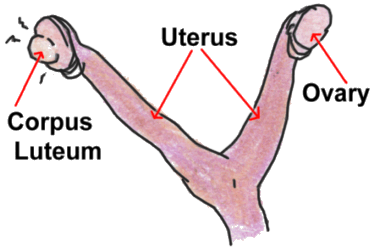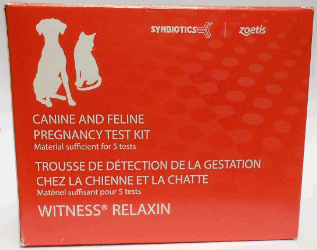|
FALSE PREGNANCY (CANINE)

Canine False Pregnancy and Female Reproduction

Rosie has built a nest and now considers her toys
(and possibly some of the cushions) to be her puppies.
(original graphic by marvistavet.com)
We get a lot of questions about female dogs having their menstrual periods. Do dogs have menstrual periods? How long do they last? How often do they come?
In fact, the menstrual cycle is a primate phenomenon; dogs do not have menstrual periods. They have an estrus cycle that includes a bloody vaginal discharge (hence the confusion about menstrual periods) and a period of false pregnancy. This false pregnancy, or pseudocyesis (pronounced “sudo-sigh-eesis”), can get out of control, lasting for weeks with the dog producing milk and sometimes mothering soft toys or pillows like “Rosie” in the above illustration. So what should one do when this happens?
THE NORMAL FEMALE DOG REPRODUCTIVE CYCLE
Before talking about treatment, let’s explain the natural estrus cycle of the dog. The female dog comes into season approximately every 6 to 8 months, though this period becomes more erratic with age, is somewhat irregular when cycles first begin, and can come at longer intervals in certain breeds. When female dogs get older (say, age 7 or older) they do not stop cycling; there is nothing similar to menopause. Instead, as mentioned, cycles become irregular and long periods of time (years) can pass between cycles.
|

(original graphic by marvistavet.com)
|
The first phase of the cycle is called proestrus and is characterized by a swollen vulva, a bloody vaginal discharge, and attraction of male dogs. The female dog flirts with the male but will not allow him to mount. The bloody vaginal discharge is what seems to lead to the misconception that the dog is menstruating. In fact, the blood comes directly from the walls of the vagina rather than the sloughing of the uterine lining as occurs in menstruation.
|
The second phase of the cycle is called estrus, which is characterized by the change in character of the vaginal discharge from bloody to straw colored. At this time the female begins to allow the male to mount. It is classically the change from proestrus to estrus when ovulation occurs and the female is most fertile.
|
After the mating and the discharge is over, the period of diestrus begins. The female is hormonally pregnant regardless of whether or not she is actually pregnant. During this time progesterone is produced by a structure in the ovary called a corpus luteum. This structure is created in the process of ovulation (when the ova (eggs) are released). If the dog is pregnant, other hormones will eventually take over to maintain the corpus luteum for the entire 63 days of the pregnancy. If she is not pregnant, the corpus luteum will simply wear out gradually and she will go back into the period of hormonal inactivity in which she spends the bulk of her time. This process of the corpus luteum wearing out in the absence of pregnancy takes at least 70 days starting at the time of ovulation. Remember, during the 70+ days she has an active corpus luteum, her body essentially thinks she is pregnant and proceeds accordingly. All the hormones are present; only the puppies are missing. If she is actually pregnant, the corpus luteum lasts through the 63 days of pregnancy. When the puppies are ready for birth, the corpus luteum is rapidly destroyed in a completely different hormonal sequence of events.
|

Canine reproductive tract showing corpus luteum
(original graphic by marvistavet.com)
|
Because the female dog is hormonally pregnant for 70 days after ovulation,
one could say false pregnancy is a normal part of the cycle.
We only treat it as a disease when it becomes extreme or fails to resolve naturally.
CLINICAL FALSE PREGNANCY
When false pregnancy persists it can be a nuisance. The female dog can show the following signs:
- Nesting
- Mothering inanimate objects
- Lactating (giving milk)
- Abdominal distension
- She can even appear to go into labor.
Some female dogs are very sensitive to the hormonal fluctuations of their cycle. Diagnosis is made by history and physical examination rather than by blood test (though a blood test can be used to determine if she is actually pregnant or not). The key is to find symptoms of pregnancy in a female dog who is not pregnant. Symptoms generally become noticeable 6 to 12 weeks after estrus.
|
TREATMENT
If symptoms are mild, treatment is unnecessary as the condition resolves within 3 weeks. It may be tempting to put warm compresses on the breasts or wrap them to prevent milk leakage in the house but, in reality, any manipulation of the mammary tissue perpetuates milk production. It is important to minimize tactile stimulation. If the female is licking herself, she may need an Elizabethan collar to minimize stimulation. Any stimulation of the mammary tissue leads her body to think puppies are nursing and milk production will continue.
If a more aggressive approach is needed, hormonal medications can be used. Hormones that inhibit prolactin (the hormone of milk production) are currently the best choices when medications are needed. Bromocriptine can be obtained from a compounding pharmacy and is given until lactation ceases (about a week or two). Upset stomach is not unusual with this medication. Cabergoline has fewer side effects and is given similarly but tends to be more expensive. Both these medications will cause abortion if the dog actually turns out to be pregnant so it is important to be sure. A third medication called metergoline works a little differently to reduce prolactin but can also be used to end false pregnancy. Approximately 4-5 days of treatment are needed to stop the lactation and get things back to normal. Supplementing with vitamin B6 has been found to be helpful in regressing the false pregnancy as well.
|

German shepherd dog
wearing an Elizabethan collar.
(original graphic by marvistavet.com)
|

The Witness Relaxin test can reliably detect canine pregnancy after 30 days from the breeding date.
Ask your veterinarian about this blood test if you are not sure about whether your dog is pregnant.
(original graphic by marvistavet.com)
SPAY DURING FALSE PREGNANCY?
It might seem like a good idea to spay the female to end the false pregnancy as spaying will remove the ovaries and the corpora lutea they carry. Unfortunately, this does not end the prolactin production from the pituitary gland so spaying may actually prolong the false pregnancy. Spaying during the diestrus period described above can actually trigger a false pregnancy. It is best to wait until the false pregnancy is over and then spay her to prevent future episodes. It is best to spay well after the 70 day diestrus period to avoid triggering a false pregnancy.

Page last updated: 8/5/2023
|